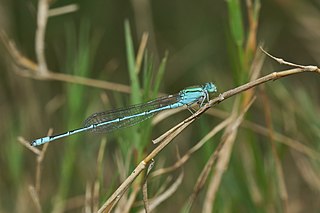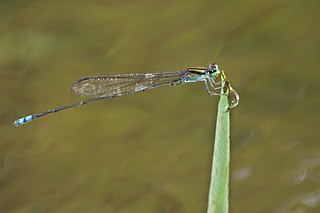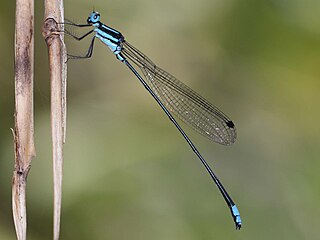
Acisoma panorpoides, the Asian pintail, trumpet tail, or grizzled pintail, is a species of dragonfly in the family Libellulidae.

Indolestes gracilis is a species of damselfly in the family Lestidae. It is known only from Sri Lanka, South India and Cambodia.

Lestes elatus is a species of damselfly in the family Lestidae, the spreadwings. It is known commonly as the emerald spreadwing. It is native to India, Thailand and Sri Lanka.

Copera marginipes, commonly known as the yellow bush dart, is a species of damselfly in the family Platycnemididae. It is native to Asia, where it is widespread and common.

Amphiallagma parvum, little blue or azure dartlet, is a species of damselfly in the family Coenagrionidae. This species can be found in many South Asian countries including India, Sri Lanka, Myanmar, Thailand, Nepal, and probably in Bangladesh.

Pseudagrion malabaricum, Malabar sprite, jungle grass dart, is a species of damselfly in the family Coenagrionidae. It is found in India, Sri Lanka, and Myanmar.

Pseudagrion rubriceps, saffron-faced blue dart, is a species of damselfly in the family Coenagrionidae. It is found in many tropical Asian countries.

Pseudagrion decorum, elegant sprite or three striped blue dart, is a species of damselfly in the family Coenagrionidae. It is found in many tropical Asian countries.

Pseudagrion indicum, yellow-striped blue dart or yellow-striped dart, is a species of damselfly in the family Coenagrionidae. It is found only in Western Ghats of India.

Caconeura ramburi is a damselfly species in the family Platycnemididae. It is commonly known as the Coorg Bambootail or Indian blue bambootail. It is endemic to the Western Ghats.

Caconeura risi is a damselfly species in the family Platycnemididae. It is endemic to Western Ghats.

Disparoneura apicalis, black-tipped bambootail is a damselfly species in the family Platycnemididae. It is endemic to Western Ghats. It was described from Kodagu, Karnataka, on the upper reaches of the Kaveri River. It is also found to occur in Kuruvadweep, Wayanad, Kerala, along the banks of Kabini River.

Phylloneura westermanni, Myristica bambootail is a damselfly species in the family Platycnemididae. It is endemic to Myristica swamps of Western Ghats in India. The habitat is restricted to a few localities in Karnataka, Kerala and Tamil Nadu.

Esme mudiensis is a damselfly in the family Platycnemididae. It is commonly known as the Travancore bambootail. It is endemic to the Western Ghats in India, particularly south of Palakkad Gap.

Esme cyaneovittata is damselfly in the family Platycnemididae. It is endemic to Western Ghats in India, south of Palakkad Gap.

Indosticta deccanensis, the saffron reedtail, is a damselfly species in the family Platystictidae. It is endemic to Western Ghats in India.

Lestes dorothea, the forest spreadwing, is a damselfly species in the family Lestidae. It is distributed from south and northeast India to Thailand and Malaysia.

Indolestes pulcherrimus is a species of spreadwing in the damselfly family Lestidae. The species was known only from in Kodagu district, Karnataka. Later it is found in forest swamps in Wayanad district, Kerala too.

Ischnura rubilio, western golden dartlet, is a species of damselfly in the family Coenagrionidae. It is found in Indian subcontinent and Iran.

Davidioides martini, Syrandiri clubtail, is a species of dragonfly in the family Gomphidae. It is known only from the Western Ghats of India.





















